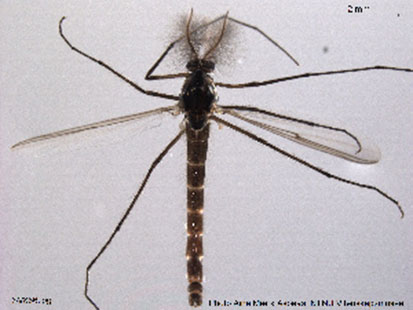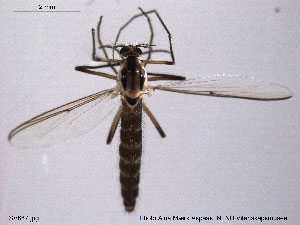Species 5n Chironomus lugubrisThe COI sequences, however, indicate that this material is not synonymous with species 5c. This constitutes the first record of C. lugubris in North America and hence suggests that this species has a Holarctic distribution. In BOLD Bin: BOLD:AAB4581. Nearest neighor Bin: BOLD:ADL5630 - species TE11. Adult:  Photograph by Elisabeth Stur LR about 1.3; anterior tarsi without a long beard (Pinder 1958). Abdomen with a thin pale band at the posterior margin of each segment. About 11 setae on tergite IX, some in individual pale areas and others in a larger area. Hypopygium quite similar to that of C. riparius except that the gonostylus narrows more gently over the posterior third. Superior volsella of Strenzke's (1959) S-type but more pointed than that shown in Fig. 55F of Pinder (1958) (so, is this the same species as Pinder’s C. lugubris?).  Photograph by Elisabeth Stur Wing length about 3.5 mm, width about 1.6 mm; VR about 0.84. Pupa: No definite data. Langton & Visser (2003) describe a pupa, but there is uncertainty as to whether it refers to the species considered here. Larva: According to Wülker et al. the larva should be a thummi-type. Cytology: According to Wülker et al. the polytene chromosomes should have the pseudothummi arm combination AE, BF, CD, G, although the basis for this information is not given. Molecular data Found: Yukon Territory - Ivvavik National Park (69.162°N, 140.155°W) (BOLD BIOUG17183-B09). |
Modified: 6 April 2021
Access: Unrestricted
Copyright © 2020-2021, Jon Martin.